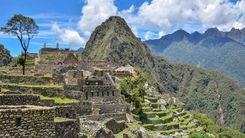Brief history
Located 1750m above the Apurimac River and 3104m above sea level in the district of Vilcabamba, Choquequirao is thought to have been a rural retreat for the Inca emperor as well as a ceremonial centre. It was built in the late fifteenth century and almost certainly had an important political, military and economic role, controlling people and produce between the rainforest communities of the Ashaninka, who still live further down the Apurimac River, and the Andean towns and villages of the Incas. It’s easy to imagine coca, macaw feathers, manioc, salt and other Ashaninka products making their way to Cusco via Choquequirao.
Hiram Bingham came to Choquequirao in 1910 on his search for lost Inca cities. Regardless of the exquisite stonework of the ceremonial complex and the megalithic agricultural terracing, Bingham – as have many archeologists since – failed to see just how important a citadel Choquequirao actually was. Evidence from digs here suggest that a large population continuously inhabited Choquequirao and nearby settlements, even after the Spanish Conquest.
The trek to Choquequirao
The most direct route up is along the Abancay road from Cusco – about four hours – to Cachora in Apurímac, over 100km from Cusco and some 93km north of Abancay; from here it’s a further 30km (15–20 hours) of heavy but stunningly beautiful trekking to the remains of the Choquequirao citadel. A longer and even more scenic route involves taking a twelve-day hike from Huancacalle and Pukyura and then over the Pumasillo range, through Yanama, Minas Victoria, Choquequirao and across the Apurímac ending in Cachora.
Taking the direct route, the first two hours are spent hiking to Capuliyo, where, at 2915m, there are fantastic panoramas over the Apurímac Valley. The trail descends almost 1500m from here to Playa Rosalina on the banks of the Río Apurímac, where it’s possible to camp the first night. The second day has the most gruelling uphill walking – about five hours as far as Raqaypata and a further two or three to Choquequirao itself.
The site
Consisting of nine main sectors, the site was a political and religious centre, well served by a complex system of aqueducts, canals and springs. Most of the buildings are set around the main ceremonial courtyard or plaza and are surrounded by well-preserved and stylish Inca agricultural terracing.



